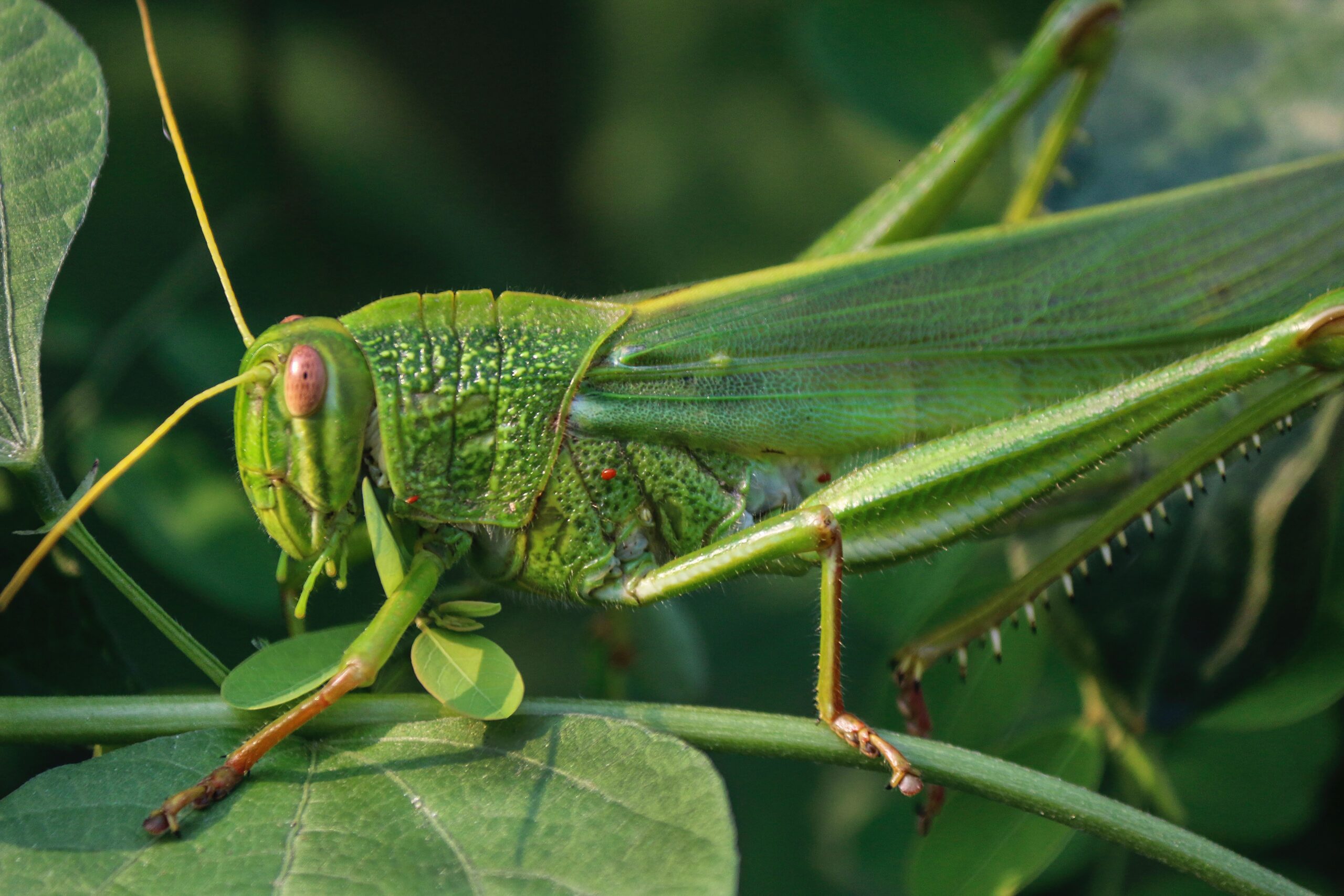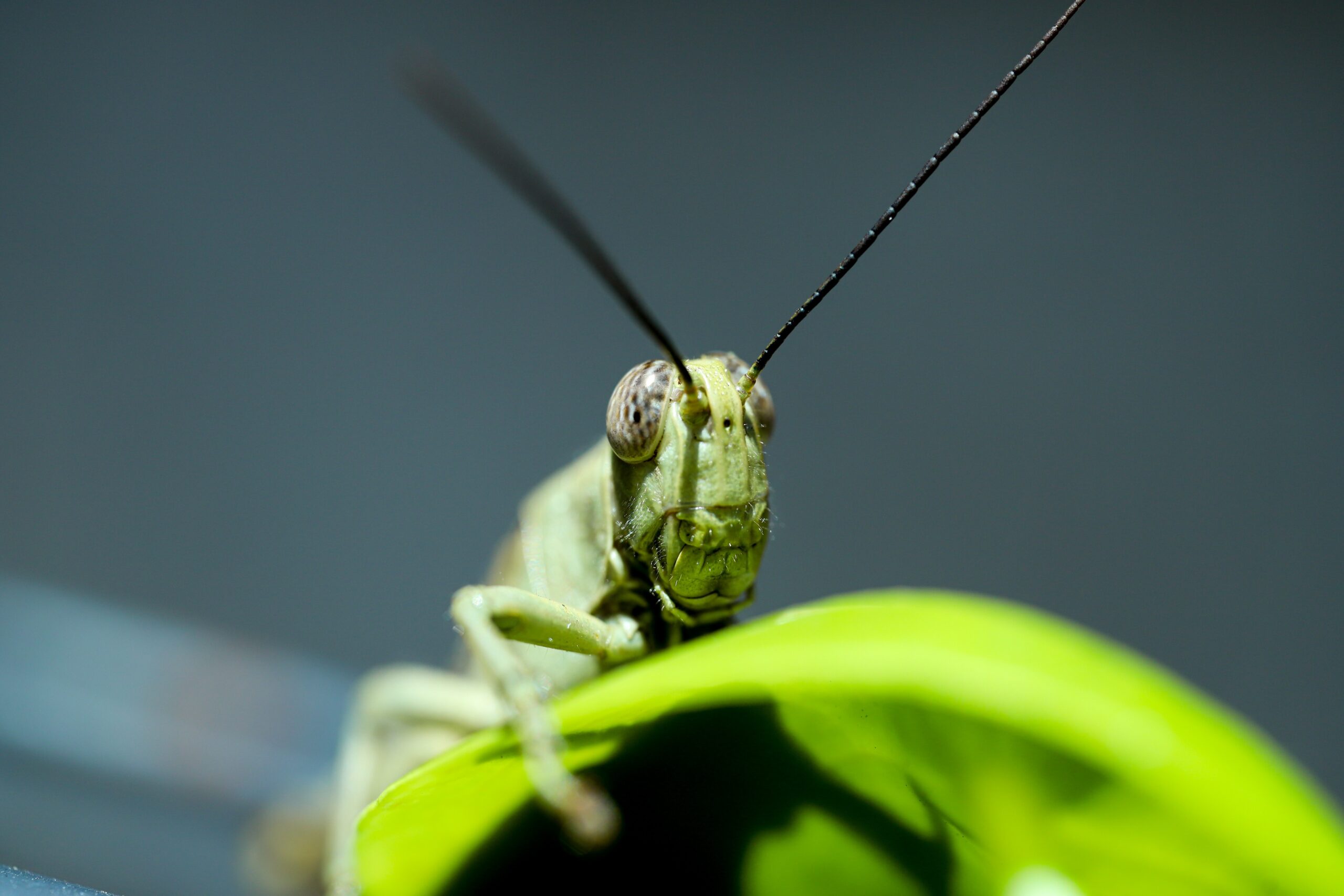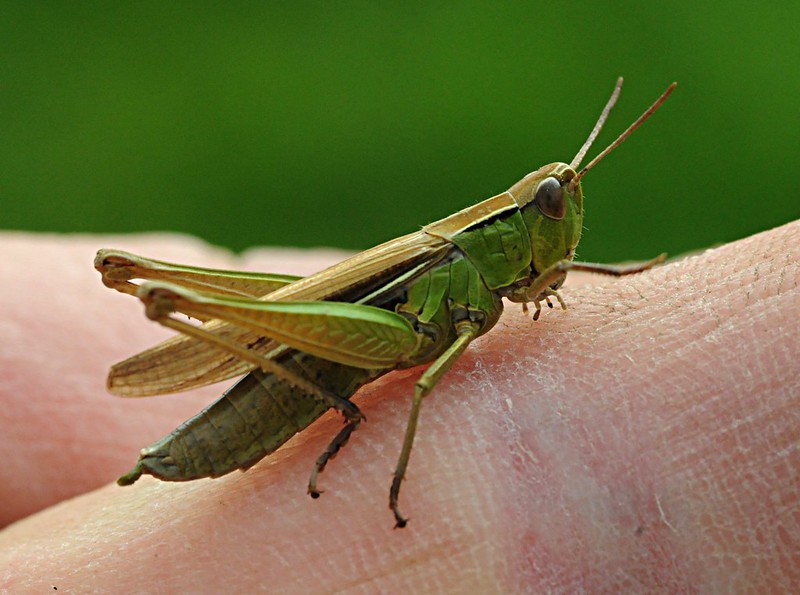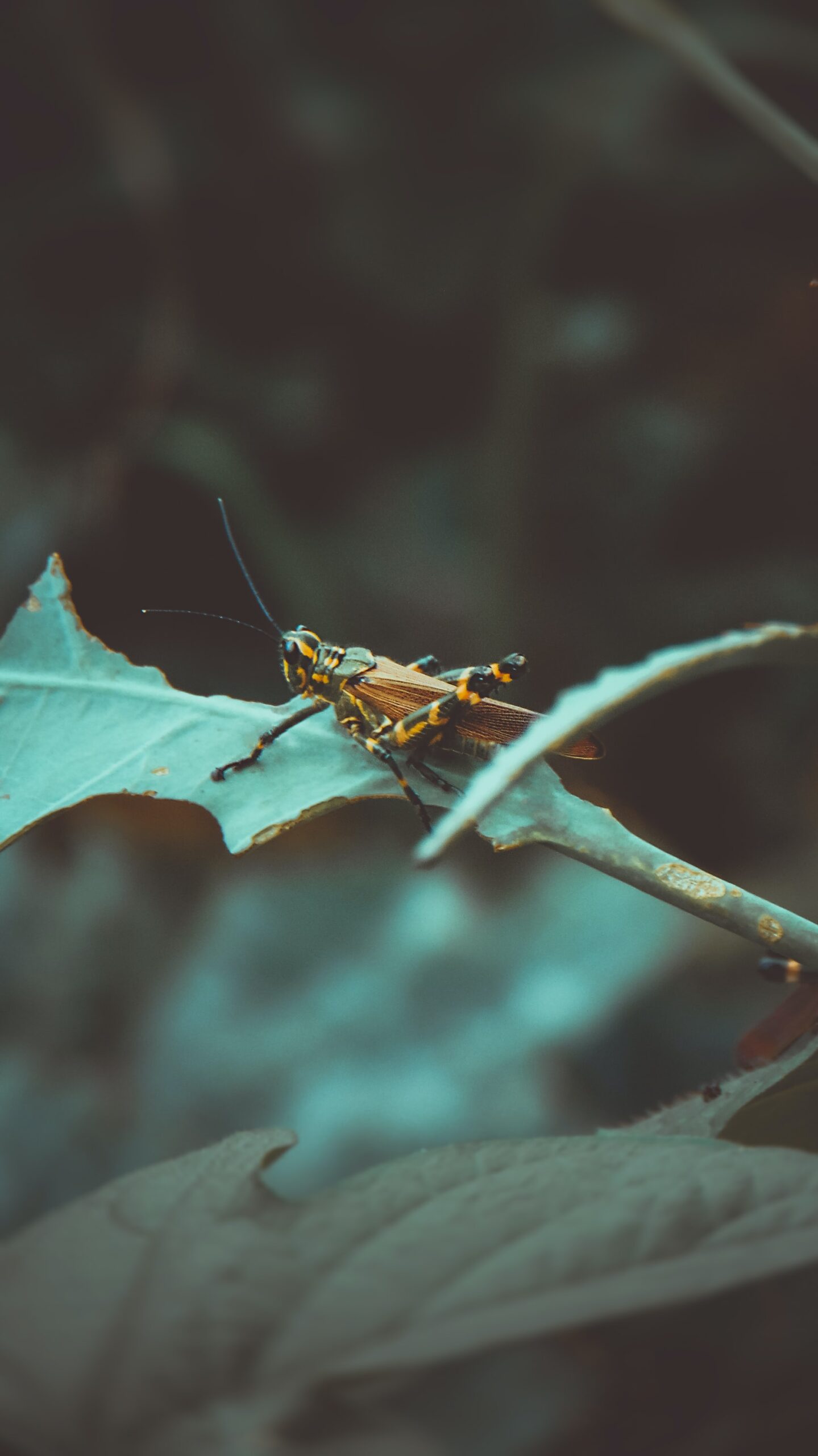Have you ever been out in your backyard and see a grasshopper sitting on top of a flower? Given that there are more than 11,000 species of grasshoppers encountering one is far from unusual. Depending on the species, these bugs range from an inch to about three inches. So, should we be afraid of grasshoppers? Do they bite? Read on to find out!

Grasshoppers have mouthparts adapted for chewing, which they use to strip away plant tissue.
RELATED: What Is Eating My Zinnia Leaves? Causes & Quick Solutions
Imagine enjoying a leisurely stroll through your yard, appreciating the lawn you have labored so hard to keep mowing and looking its best. Then, suddenly, you come across a grasshopper. For a moment, you wonder if it’s safe to let it jump on you, but then you remember that you heard someone say grasshoppers bite. So, what should you do?
To answer your question, grasshoppers typically do not bite people. They will only attack if they feel trapped and have no other option.
And even if they do, they can’t do us much harm because their mouths are too small. In addition, grasshoppers don’t have venom, so people don’t have to worry about getting sick from their bites.
That said, there’s a lot more to grasshoppers and their bites!
Read on to find out!
What Attracts Grasshoppers?
Grasshoppers are attracted to places with few predators, good hiding spots, and lots of food.

Grasshoppers are pesky insects that can invade just about any outdoor space, including your lawn, garden, patio, and even indoors. However, they primarily consume fruits, trees, crops, gardens, flowers, shrubs, and nearly anything else that is growing in a lush green state in and around your house. As is often the case, these critters follow their noses and seek out food and shelter. In particular, grasshoppers are drawn to gardens with:
Few Predators
The presence of fewer natural predators, such as birds, spiders, and lizards, will naturally lead to an increase in the grasshopper population in an area.
Good Hiding Spots
Grasshoppers favor habitats that are rich in weeds and plants as these environments offer a greater variety of food sources, places to hide from predators, and spaces in which to lay their eggs. So, if that is what your backyard is like, you’re in trouble.
Tasty Crops
Grasshoppers are herbivores that prefer grasses, alfalfa, corn, clover, and tiny grains, but they will eat just about everything. So you might be inviting swarms of grasshoppers into your garden if you plant any of these crops in an especially thick manner.
RELATED: What Is Eating My Plants At Night? Learn About The Evil Creatures Involved!
What Do Grasshoppers Eat?
Grasshoppers seem to choose cereal grains, legumes, and grasses over other plants in their natural habitat.

Since grasshoppers may be found in so many diverse environments, it stands to reason that they have widely varying diets. However, the vast majority of grasshoppers are herbivores, meaning they consume a wide variety of plants in their diet.
RELATED: What Is Eating My Pea Plants? Causes, Solution & Prevention
They prefer to consume leaves, blossoms, stems, and seeds for the most part. However, there are times when they will also consume dead insects.
Under particular environmental conditions and high population densities, grasshoppers change color and behavior to create swarms. It only takes a small group of grasshoppers to eradicate an entire crop, and in many parts of the world, it is not unusual to suffer a loss of 25% of a crop to grasshoppers during each growing season.
Found a grasshopper in the wild? Bring it inside and feed it some clean lettuce, kale, or cabbage so you can watch it eat and learn more about it.
Their favorite foods are grains, flowers, and grasses; if given a chance, they will devour all three of these things with gusto. However, if there aren’t any plants around, they will eat dead animals or feces to supplement the protein they need.
Do Grasshoppers Bite Humans?
Grasshoppers rarely, if ever, bite humans. However, some that swarm may bite.

Well, let’s get to the meat of the matter. Can you get bit by a grasshopper? The answer is yes; they can bite; they do occasionally bite, although it’s not very often. So, would it bite you if you were to pick up a grasshopper? Well, the answer is most likely no.
And, even if someone were to get bitten by a grasshopper, they might feel a slight pinch, but more than likely, they wouldn’t feel anything at all. Keep in mind that the mandibles of a grasshopper are not designed to cut human skin but rather leaves and stems.
Also, these insects have considerably more to lose than gain from a fast nip as they cannot physically hurt their opponent yet face a major chance of being crushed or killed.
So, they would only bite us if they were extremely frantic to get away. The most likely cause of this would be a person lifting them up and gripping them tightly.
Are Grasshoppers Poisonous?
Since grasshoppers lack venom, they pose no danger to humans. So, even if a human were to be bitten by a grasshopper, the bite would not have the same long-lasting impact as a sting from a bee, although it may hurt a bit for a short while. Nevertheless, there is no reason to be concerned that a grasshopper may inject venom or poison if it happens to bite you because grasshoppers do not produce any of these substances.
Do Grasshoppers Spit?
Grasshoppers have evolved the ability to spit forth a dark liquid as a defensive mechanism.

When grasshoppers feel threatened, they will spew what is scientifically called as “defensive regurgitation,” although you might also call it “grasshopper spit.”
The spit is unpleasant to look at and contains partially digested plant material in addition to digestive enzymes; however, it is not dangerous. And just so you know, the grasshopper spit really is revolting to taste. So, if you don’t believe me, the best way to convince yourself is to sample some grasshopper spit the next time it gets on your hands.
In scientific parlance, we refer to this activity as research.
The term “tobacco spit” is also sometimes used to refer to grasshoppers’ spit. But don’t be fooled: scientific studies have shown that their saliva does not contain any tobacco.
It is likely given that name due to the fact that, previously, grasshoppers have been linked with tobacco plantations. In addition, the saliva is not corrosive and poses no genuine threat in any form. The truth is, this is hardly a defense mechanism.
The only effect that this grasshopper spit will have on you is to stain your skin and possibly make you smell. Therefore, if you wish to avoid the juice from the grasshoppers staining your skin, you should probably handle them while wearing gloves.
How To Treat A Grasshopper Bite?
If a grasshopper bites you, cleanse the bite area with warm water and mild soap.

Even though gasshopper bites do not pose a significant health risk, they can be somewhat unpleasant. Grasshopper bites, like those of other insects, typically result in the formation of a raised, red lump on the victim’s skin. And even though grasshopper bites do not spread disease, microorganisms from the environment can get into the wound.
Therefore, it is essential to thoroughly clean the area where the bite occurred to ensure that no additional impurities present could cause inflammation. So, if you get bitten by a grasshopper, you can use the following first aid measures:
- Clear away any remains of debris that the bite may have left behind.
- After that, wash the area where you were bitten with warm water and gentle soap.
- If the bite is experiencing any swelling, apply a cold compress or ice pack.
- An over-the-counter pain reliever such as Advil can help if you have pain.
- If itching, try using an anti-itch lotion like hydrocortisone on the affected area.
- It is essential to refrain from scratching the area until the bite has healed.
- The bite shouldn’t take more than a few days to heal. See a doctor if it’s infected.
How To Get Rid Of Grasshoppers?
Grasshoppers aren’t picky eaters; they’ll eat just about anything you’ve spent the season cultivating in your garden. Also, farmers and those who grow at home have a significant challenge when faced with grasshoppers in big numbers.
Not only are they able to freely migrate between plantings within a single landscape, but they can also travel large distances as they travel from one area to another.
However, do not worry. We have got you covered.
Here is how to get rid of these nasty bugs.
1. Identifying Grasshoppers & Their Damage
The damage caused by grasshoppers appears as round to jagged holes in the leaves.

Grasshoppers can be found in almost every state in the United States. They appear in many colors, including green, gold, and brown. If you are having trouble locating grasshoppers, you should listen out for a chirping sound, as that is their primary mode of communication.
Also, check the leaves on your lawn or in your garden for any signs of gnaw marks or holes; this is a sure sign that they are present. Grasshoppers make their first appearance in the early spring, but the peak of their population is typically around the middle of July.
Grasshoppers can occasionally be confused with katydids or crickets, but their lengthy hind legs and two sets of wings make them relatively straightforward to identify.
Damage caused by grasshoppers is most likely to occur in the central United States, which includes states ranging from Montana and Minnesota through New Mexico and Texas.
Grasshopper Damage
Grasshoppers are one of the most damaging pests that can infest residential gardens, agricultural fields, and rangelands. The damage caused by grasshoppers appears as round to jagged holes in the leaves. These irregular holes penetrate the leaf tissue between the veins and extend inward from the leaf margins.
In addition, damage caused by grasshoppers occurs in cycles as their populations build up from year to year and travel in search of food.
Grasshopper Lifecycle
The life cycle of a grasshopper contains three distinct stages, which are as follows:
Egg
The grasshopper egg is the first stage of the insect’s life cycle. The female grasshopper deposits her fertilized eggs on the sand or among leaf litter during the middle of summer. They are deposited in a frothy material that makes them resemble grains of rice and serves to shield them as they incubate. There the eggs will stay dormant for roughly ten months until the spring or early summer, when nymphs will hatch from them.
Nymphs
After hatching from their eggs, nymphs forage aimlessly in search of fresh plant matter to eat. Nymphs resemble full-grown grasshoppers save for the lack of wings and genitalia.
Before maturing into adults, nymphs go through a series of five to six molts. It takes the immature nymphs roughly five to six weeks to develop into full-grown adults.
Adult
Adult grasshoppers are the THIRD and final stage of the grasshopper life cycle.
A full set of wings might take up to a month to develop. Adults reach sexual maturity in around 15 days and can live for another 30 days. Also, they have wings and can hop great distances. Their reproductive organs are also completely developed.
2. Treating The Affected Areas For Grasshoppers
Grasshoppers and many other types of insects can be driven away by strong-smelling substances.

After discovering that you have an infestation, the next step is to treat the areas that the grasshoppers have impacted. You can employ natural or organic approaches or even animals to reduce the number of grasshoppers in your yard and gardens.
Animal Control For Grasshoppers
If you have the luxury of keeping animals in your yard, you may put those creatures to work for you by keeping these insects under control. Listed below are two examples of animals that prey on grasshoppers in their native habitat.
Birds
A good hopper is also a tasty treat for wild birds to eat every once in a while. Try to attract grasshopper-eating birds to your garden during the summer so they can feast on them.
Chickens
Grasshoppers are a delicious treat for various fowl, including chickens, guinea hens, and even ducks. Chickens are not herbivores as many grocery stores would have you think; instead, they are omnivores that enjoy eating insects and are not vegetarians.
Apply Biological Control
If biological control is your goal, stay away from pyrethroids. These pesticides are not organic pesticides as they contain synthetic chemical ingredients. Fungi like Nosema locustae and Beauveria bassiana, which interfere with the digestion of grasshoppers, are also among the other preventative treatments that are effective for grasshoppers.
Set Up Bait Traps
A wide variety of bait traps are available, each with its own specific method for luring in and killing grasshoppers. A molasses trap is a simple bait trap that you can make yourself.
All you need to do is place a bowl filled with 90% water and 10 % molasses. The insects will be drawn to molasses, and once they enter the water, they cannot escape.
Dust The Leaves With Flour
Grasshoppers can be killed by flour as it clogs their mouths and makes it impossible for them to eat. Do not use any other flour as it may contain things such as salt.
Instead, get some plain all-purpose flour and spread a thin coating on the leaves of the plants being affected. The grasshoppers will begin to consume the flour that is on the plant foliage, and as a result, they will finally starve to death.
Use Diatomaceous Spray
Diatomaceous earth is derived from the fossilized skeletons of algae. Grasshoppers and other insects with delicate exoskeletons are easily killed by the Diatomaceous earth when they come into contact with it because it swiftly dehydrates their bodies.
You can either combine it with water and apply it with a sprayer or by dusting it on crops or in regions infected with grasshoppers.
Use Neem Oil
Neem oil is a common organic treatment that is put to use as a fungicide in addition to its usage as a pesticide. It has been demonstrated that it deters grasshoppers and prevents them from laying eggs. This interrupts their life cycle, which, ideally, would free you from the burden of having to deal with them in the upcoming spring.
Use Garlic Spray
It has been demonstrated that spraying grasshoppers with garlic is an effective method of control for it. Garlic has a strong odor and flavor that this insects find offensive, so spraying your plants with garlic-flavored pesticide is an excellent approach to protect them from the grasshopper’s voracious appetite.
You can make your own garlic spray, but if you want to buy one, Amazon has a wide selection of excellent commercial garlic sprays.
3. Cleaning After Treating The Area For Grasshoppers
You may get rid of grasshoppers in your garden by removing them by hand. When dealing with only a small number of grasshoppers, this strategy proves to be very effective.
The best time to get rid of them is in the early morning or dusk when the temperatures are cooler and the grasshoppers move more slowly.
Put on gloves, then pluck the grasshoppers off, put them in a bowl of soapy water, or put them in a container and toss them as far away as you can.
4. Preventing Grasshoppers From Coming Back
By tilling the soil, you can put an end to the life cycle of grasshoppers and prevent them from hatching.

There are a few different approaches you can take to stop grasshoppers from getting into your garden and growing in huge numbers: Here are a few:
Prune Your Plants
Grasshopper nymphs and adults will have fewer places to hide if you keep your garden free of weeds and trim the areas around it. In addition, this will also increase the likelihood that they will be eaten by animals/birds that are native to the area.
Till The Soil
Grasshopper females will deposit their eggs on the host plant and the surrounding soil. You can stop the life cycle of new grasshoppers by tilling the soil in your garden. This will result in the destruction of any eggs that it have recently laid.
Plant These Flowers
Choosing plants that grasshoppers find unappetizing is one way to discourage them from congregating in the garden and the surroundings surrounding it.
Artemisia, Crepe myrtle, Dianthus, Forsythia, Jasmine, Juniper, Lantana, Lilac, Moss rose, Sage, Salvia, and Verbena are some examples of these plants.
Final Thoughts
So, now that we’ve got that out of the way…do grasshoppers bite? Yes, they are capable of biting, but as we have established, the likelihood of being bitten is quite remote, and the effects are only temporary. Therefore, it is best to just let them live their lives.
However, if you really do want to get rid of them, this article contains numerous helpful tips for dealing with grasshoppers in your backyard or garden.
Frequently Asked Questions
Can I pick up a grasshopper?
Grasshoppers can be removed from plants manually if doing so makes you feel at ease. However, they are delicate and should be handled with care. In addition, they are not dangerous because they do not possess venom. This means a human would suffer no long-term consequences from a grasshopper bite.
Do grasshoppers have teeth?
No, grasshoppers do not have any teeth in their mouths. Instead, they have large mandibles that are able to grind up twigs and leaves with ease. The eating typically starts on the outside margins of the leaves, and the area that has been chewed becomes ragged.
Do grasshoppers have a stinger?
Grasshoppers are, without a doubt, the most peaceful among all insects. They do not possess stingers and only occasionally resort to biting as a kind of self-defense.
The females, on the other hand, have an appendage called an ovipositor, which can resemble a stinger and is used to deposit eggs.
What scares away grasshoppers?
Cayenne pepper, garlic, and onion all have odors that grasshoppers find repulsive. Grasshoppers use the antennae on their head to detect scents and locate potential sources of food and shelter. If you apply a spray containing hot peppers designed to deter grasshoppers to the leaves of your plants, the grasshoppers will stay away.
Are grasshoppers blind?
No grasshoppers are ot blind. Grasshoppers have eyesight that is strikingly distinct from human vision, as well as the vision of a great many other organisms.
Grasshoppers have compound eyes, allowing them to see in color but at a detectable frequency range higher than humans.
Sources For Further Reading
Grasshopper Control in Gardens and Landscapes – Oklahoma State University. (2017). Retrieved 6 November 2022, from https://extension.okstate.edu/fact-sheets/grasshopper-control-in-gardens-and-landscapes.html
Grasshopper Control. University of Minnesota Extension. (2021). Retrieved 6 November 2022, from https://extension.umn.edu/news/grasshopper-control
We hope you learned something from this article, here are other articles that you can learn from:
All About Worm Castings and Their Benefits to Plants & Soil!
Effective Ways To Get Rid Of Russet Mites On Houseplants
Fungus Gnats in Houseplants & How to Identify and Effectively Control Them?







